Sicilian Easter in the Register of Intangible Heritage of Sicily (REIS)
There are 17 Sicilian municipalities that until now have seen their initiatives recognized on the occasion of Easter, in the register of the REIS Regional Intangible Heritage. In reality, many other places could aspire to this recognition, given that the Rites of Holy Week have been substantially present, for many centuries now, in almost all the municipalities of Sicily with significant involvement of the population.
List of assets recognized in the REIS:
- Holy Week and Vare in Caltanissetta and San Cataldo - CL (The Mysteries)
- Holy Week in Biancavilla - CT (in sira dei tri Misteri)
- Good Friday procession in Enna - EN
- Holy Week in Barrafranca - EN
- Holy Week and Easter - Aidone - EN
- Holy Week in Ispica - RG
- Celebrations and Rites of Holy Week in Scicli - RG
- Holy Week in Ragusa Ibla - RG
- Representation of Good Friday in Vittoria - RG (The parties ro Signuri)
- Sacred Representations of Holy Week in Capaci (PA)
- Procession of the Mysteries of Good Friday in Barcellona Pozzo di Gotto (ME)
- Arches of Pani (San Biagio Platani) - AG
- Festival of li Schietti in Terrasini (PA)
- Feast of the Devil and Angelicata in Adrano - CT (I Diavulazzi i Easter)
- Fanfare of the Jews San a Fratello (ME)
- Feast of the Risen Christ King in Scicli - RG (Feast of the Omu vivu o 'u Joy)
- Religious singing: La Santa Cruci in Riesi - CL
- Lu Signuri di li Fasci in Pietraperzia - EN
Below is a brief description extracted, when existing from the regional technical sheets, of the assets included in the REIS. For more information, access the files inserted in the Data Bank of the Intangible Heritage of Sicily
Holy Week and Going to Caltanissetta and San Cataldo (The Mysteries)
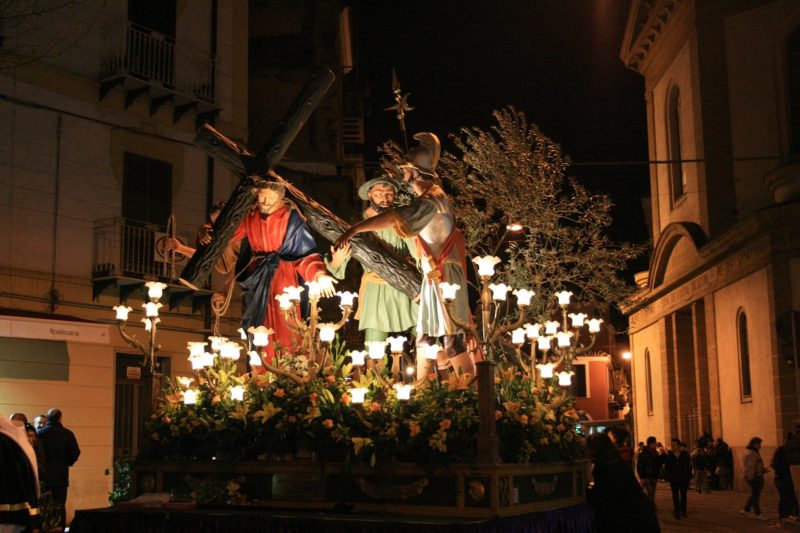
The sheet on the Data Bank of the Intangible Heritage of Sicily
***
Holy Week - Biancavilla (a sira dei tri Misteri)


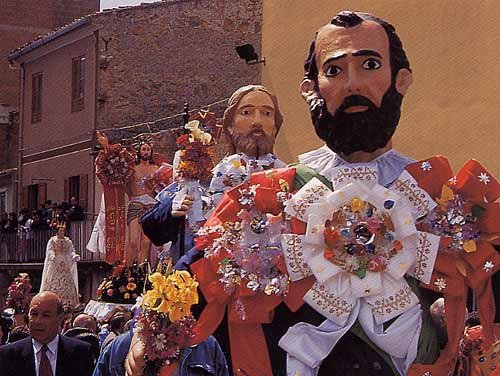
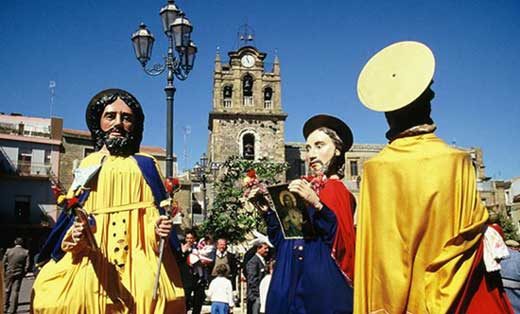
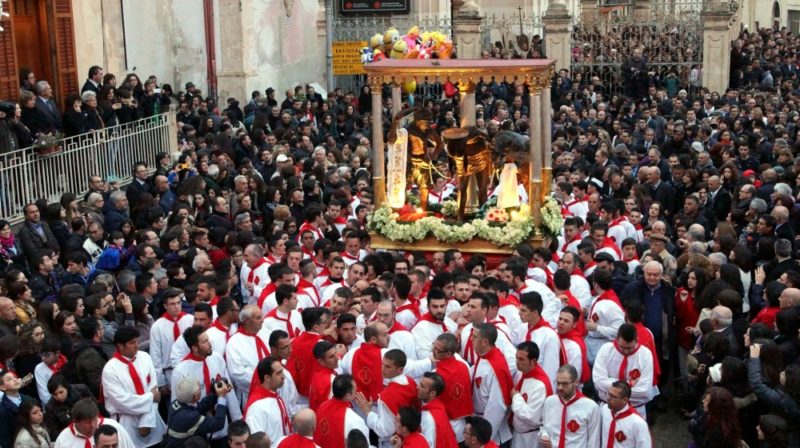
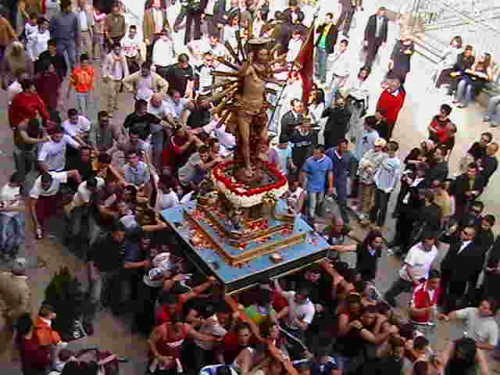
Holy Week - Ragusa Ibla - RG
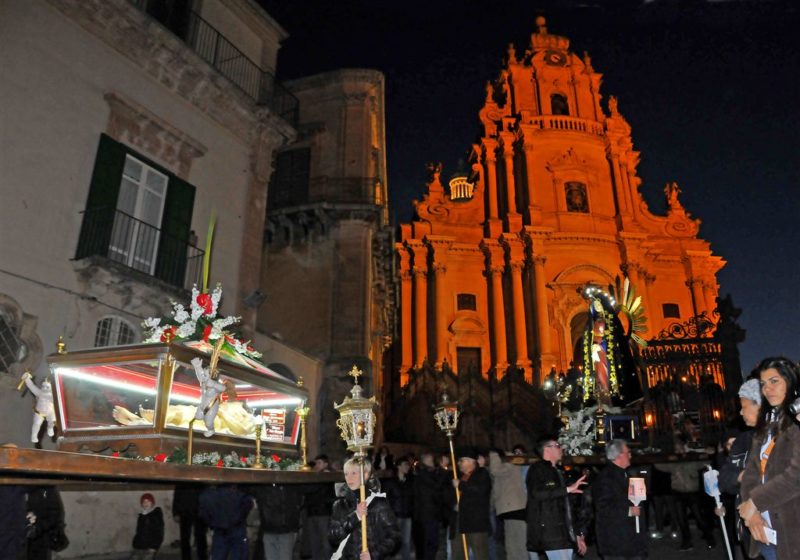
The sheet on the Data Bank of the Intangible Heritage of Sicily
***
Representation of Good Friday in Vittoria - RG (The parties ro Signuri)
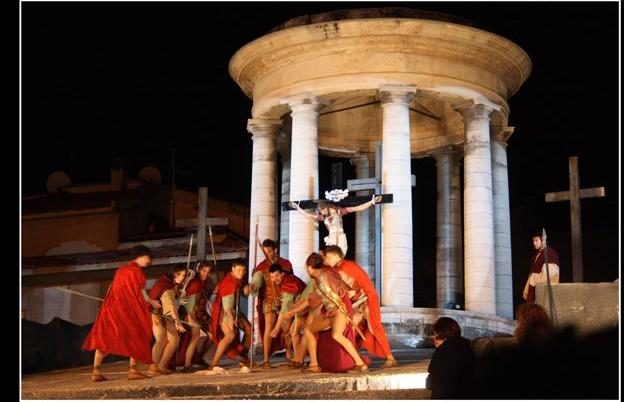
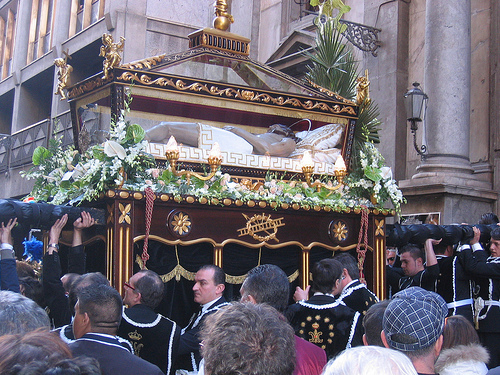
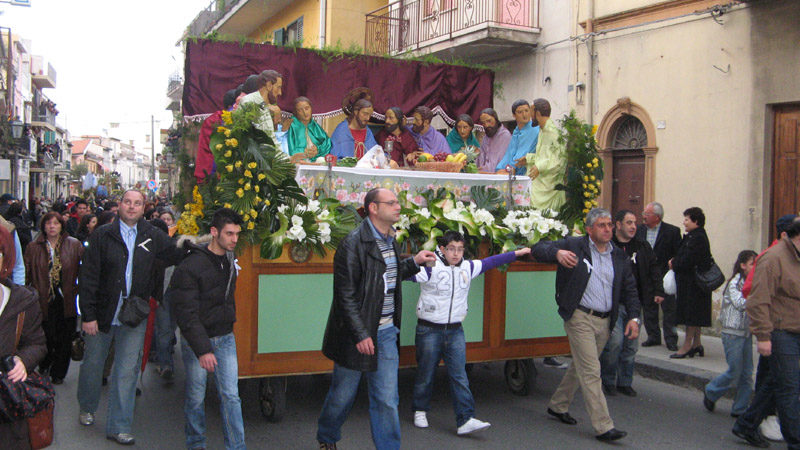
Arches of Pani (San Biagio Platani) - AG
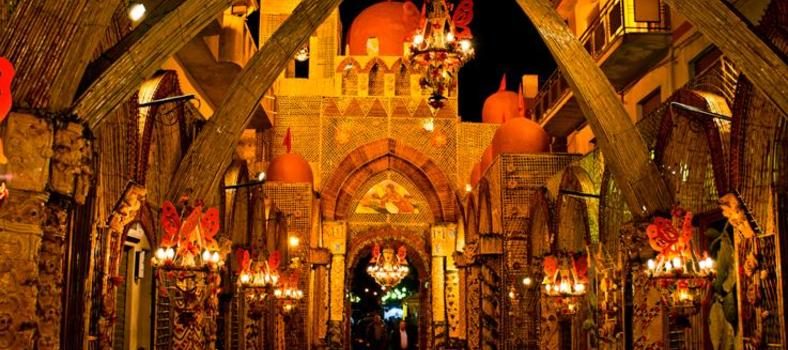
The origin of the festival dates back to the mid-seventeenth century, when the town was founded. Originally the tradition would seem to have taken place from the use of hanging bread donuts (cudduri) to the balconies to be blessed with the passage of the Madonna and the Risen Christ.
Every year, on Easter Sunday, in the small town of Agrigento, a challenge is celebrated between the devotees of the Madonna, who belong to the brotherhood of the Blessed Sacrament and the devotees of the dead Christ who belong to the brotherhood of the Blessed Rosary. The competition consists in setting up enormous scaffolding that form the architectural backdrop to the encounter between the Mother and the Risen Son on Easter day. Along the main street of the town, where the Mother Church rises from which the statues will come out, two monumental arches are set up which divide the surrounding space into two distinct areas of relevance. The arches are made on plant structures of ferule and reeds and covered with loaves, citrus fruits, bay leaves, dates, flowers and rosemary. Their preparation began a few weeks earlier, transforming the town into a large construction site where men devote themselves to large scaffolding, while women create the figurative elements. Along the surface of these grandiose and spectacular ephemeral architectures, a series of figurative paintings with sacred subjects follow one another. Zoomorphic figures prevail: fish and butterflies, eagles and cockerels, doves and lambs but there are also angels, stars, hearts and monstrances. On these small bas-relief paintings made of bread, a recurring subject is the facade of the Mother Church. To give more shine to the compositions, the loaves are glazed with a bright white, obtained from the mixture of egg white and sugar and take the name of murmured. They are arranged on the arches over a thick layer of cooked donuts without egg white, amidst carnations and other red flowers. Very long sequences of oranges frame the compositions. Other loaves depict biblical episodes and scenes from the Via Crucis, but also rose windows and medallions that reproduce the four seasons, swallow's nests with real moss inside, haystacks with dry stone bases, bunches of grapes and fruit baskets. Of bread are the capitals of the columns and the same coat of arms of the Municipality that stands out high on the architectural elevations.
The sheet on the Data Bank of the Intangible Heritage of Sicily
***
Festival of li Schietti in Terrasini (PA)
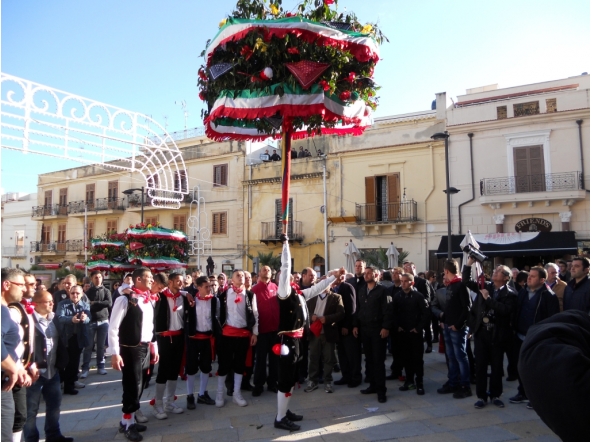
The Feast of li frank, takes place on Easter Sunday, and consists of the raising in the palm of one hand, of a melangolo, orange airu (bitter orange), a tree chosen both for its resistance and for its thaumaturgical and medical properties, weighing about 50 kilos, as proof of the physical prowess of its bearers. The winner will be the one who has held the shaft up for the longest possible time. Participants wear the typical Sicilian costume consisting of black velvet trousers and vest, white shirt, red scarf, red pompoms that act as a tie and a red cap.
The sheet on the Data Bank of the Intangible Heritage of Sicily
***
Feast of the Devil and Angelicata in Adrano - CT (I Diavulazzi i Easter)
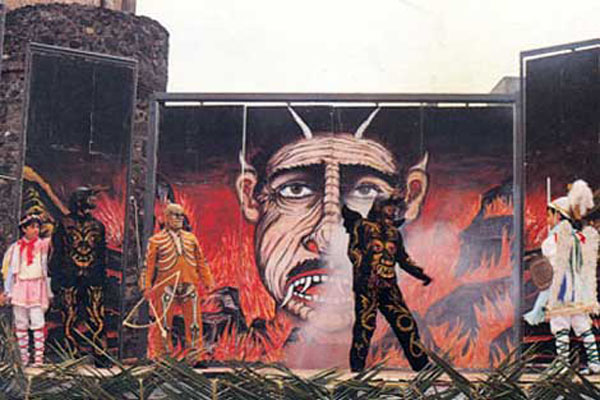
The representation of the drama dates back to the eighteenth century, the century in which Don Anselmo Laudani wrote the work. Angelicata, which represents the second part of the opera, has only been staged since 1980.
The sheet on the Data Bank of the Intangible Heritage of Sicily
***
Fanfare of the Jews San a Fratello (ME)
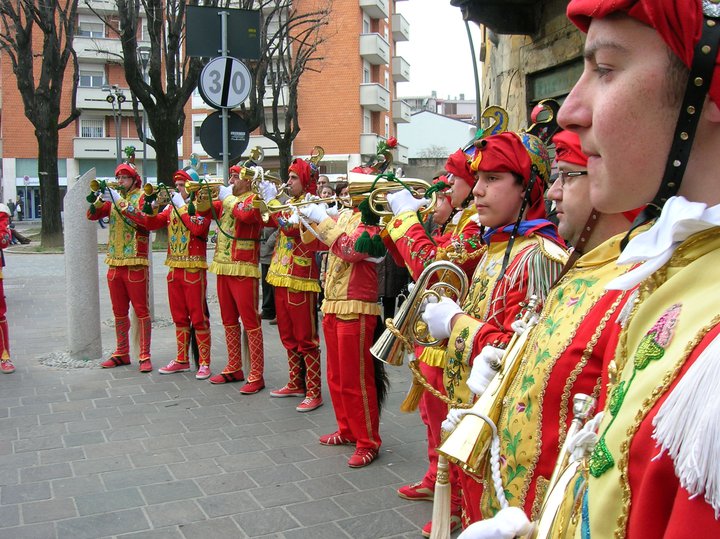
San Fratello was founded by integrating the Greek-Latin inhabitants with immigrants who came in the wake of the Lombards from Casale Monferrato with Adelaide or Adelasia degli Aleramici, from the Alto Novarese, from France and from Lombardy, in the twelfth century. In this town of the Nebrodi various elements of ancient origin remain unchanged, such as the Gallo-Italic dialect, pagan, carnival and Christian rituals. For example, in the period of Holy Week - one that is richer in events that reconcile the dramatic moment of Christ's passion with the joyful moment of the Resurrection - in San Fratello, to celebrate the expectation of the Resurrection we find a unique event of its kind, namely the " Fanfare of the Jews ”. Conducted on Wednesday, Thursday and Good Friday, the feast of profane origin, it recalls the moment in which the Jews beat and led Christ to Calvary. Scholars disagree on the origin of the festival, defining "the Jews" now as proponents of a "devil" or "hellish jumble" (Pitre), now as "disturbing figures" deriving from sacred medieval representations (Rubino - Cocchiara).
The sheet on the Data Bank of the Intangible Heritage of Sicily
***
Feast of the Risen Christ King in Scicli - RG (Feast of the Omu vivu o 'u Joy)
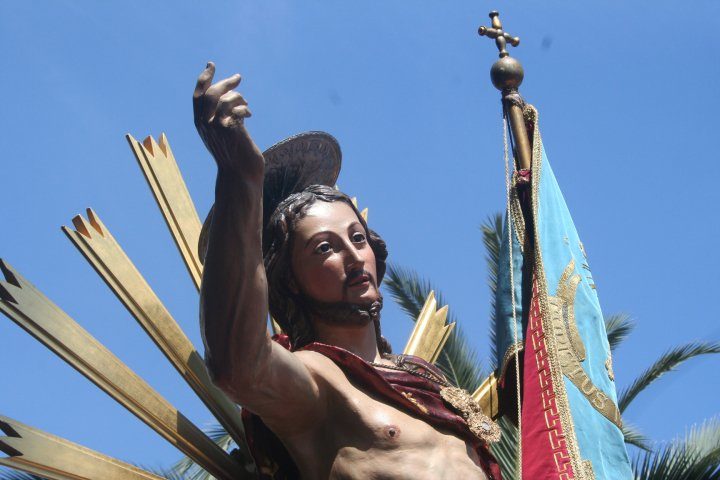
The sheet on the Data Bank of the Intangible Heritage of Sicily
***
Religious singing: La Santa Cruci in Riesi - CL
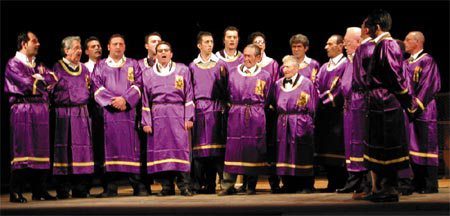
The sheet on the Data Bank of the Intangible Heritage of Sicily
***
Lu Signuri di li Fasci in Pietraperzia - EN
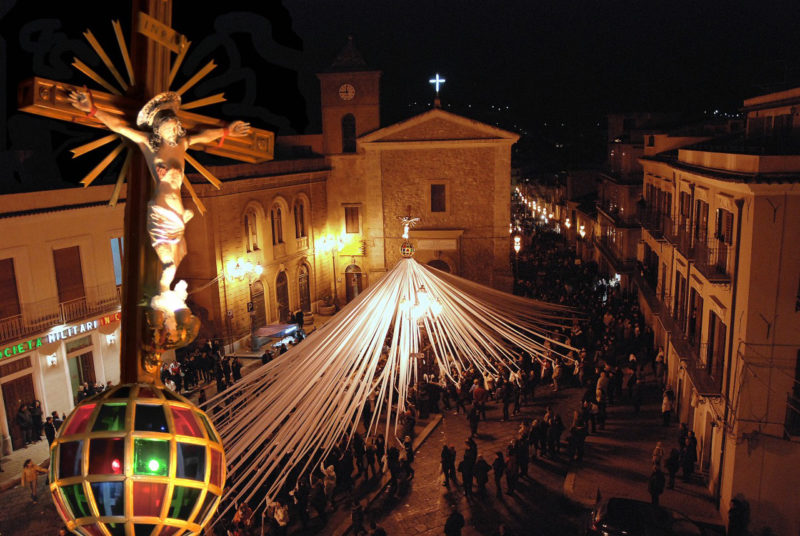
The sheet on the Data Bank of the Intangible Heritage of Sicily
All photos were taken from the web


